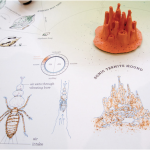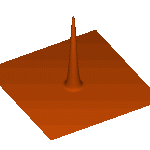Sound
Photo credit: Pixabay as posted in Discovery News
New research shows that pearlfish (Onuxodon fowleri) not only reside in black-lip pearl oyster shells, they also use the shells to amplify sounds created by vibrating their swimbladders. According to lead study author Dr. Loic Kéver, "amplification probably improves the efficiency of communication by increasing the propagation distance of the sounds."
Following high resolution CT scans, Dr. Kéver noted, "the rostral [front] end of the swimbladder forms a mineralised structure – called the rocker bone – on which insert the…
A golden retriever in a fMRI scanner. Image by ENIKO KUBINYI from The Scientist.
A paper published in Current Biology describes research using functional magnetic resonance imaging (fMRI) to compare the sound processing regions of brains in humans and dogs (border collies and golden retrievers). The subjects listened to almost 300 sounds (vocalizations from dogs and humans as well as non-vocal sounds) or no sound as a control. They used the fMRI to locate sound-sensitive regions (auditory cortex) in the human and dog brains. Not surprisingly, the human auditory cortex was mostly (87%)…
"Haters are like crickets; they make a lot of noise you can hear but you never see them, then you walk right by them and they're quiet." -Unknown
The sound of crickets adds an unavoidable hum to the evenings and nights in many places throughout the world, a familiar sound -- I'm sure -- to a great many of you.
Each male cricket has a large, serrated (sawtooth) vein running along the bottom of each wing, and by rubbing the top of one wing against the bottom of the other, while simultaneously holding the wings up-and-open, the wing membranes vibrate, and create that familiar chirping sound…
At the tail end of Tuesday's post about wind and temperature, I asked a "vaguely related fun bonus question:"
If the air molecules that surround us are moving at 500 m/s anyway, why isn't the speed of sound more like 500 m/s than 300 m/s?
This is another one that people are sometimes surprised by. The answer is simply that in a sound wave, the air molecules don't really go anywhere. When something creates a sound-- say a foolish dog barking at a perfectly harmless jogger going by outside, to choose an example completely at random-- there isn't any actual thing that travels from the noisy dog…
If you could press your ear to a ladybird's chest, what would you hear? Not the steady thump thump of a human heart, but something quite different. Discovery News reports on work carried out by Igor Sokolov and his team at Clarkson University, who used an atomic force microscope to listen to the faint sounds emanating from inside living insects.
Listen to a ladybird
The researchers used this atomic stethoscope to record the internal sounds of other insects including a fly and a mosquito, which you can listen to here.
The work is published in Applied Physics Letters.
If you’re like me, you probably pay much more attention to what you see around you than to what you hear. Maybe you even “tune out” much of the time. But actually sound is just as important as sight to our existence – maybe even more so. We hear before we see in the womb. The vibrations of sound penetrate our bodies in a way that images never do. So this fascinating program is not about dry, technical information. It’s all about waking you up to the sound world around you and to the amazing way our bodies and brains are built to perceive and process sound. You may well have no idea what…
The future potential of synthetic biology is usually discussed in terms of applications in fields like medicine, food science, and the environment. Genetically engineered life forms are being designed to make medicines cheaply, to target tumor cells, to make more nutritious food, or to make agricultural plants that are easier to grow with less of an environmental impact, to clean up pollution or produce sustainable biofuels. What if synthetic biology systems were instead designed for use in culture or entertainment?
David Benqué, a student in the Design Interactions program at the Royal…
Have you ever looked at a piano keyboard and wondered why the notes of an octave were divided up into seven white keys and five black ones? After all, the sounds that lie between one C and another form a continuous range of frequencies. And yet, throughout history and across different cultures, we have consistently divided them into these set of twelve semi-tones.
Now, Deborah Ross and colleagues from DukeUniversity have found the answer. These musical intervals actually reflect the sounds of our own speech, and are hidden in the vowels we use. Musical scales just sound right because they…
Caught this bad description of an otherwise very interesting study at Science Daily:
Neuroscientists at Georgetown University Medical Center have, for the first time, shown what brain activity looks like when someone anticipates an action or sensory input which soon follows.
In the February 25 issue of the Journal of Neuroscience, they say this neural clairvoyance involves strong activity in areas of the brain responsible for preparing the body to move.
The findings were made by using functional magnetic resonance imaging (fMRI) in a group of student volunteers who brought with them favorite…
This comes from Buzz Out Loud Episode 865 which got the story from Slashdot regarding a possible new technology that would use piezoelectric devices to charge cell phones while you talk. The original article the slashdot story pointed to talked mostly about the advances in piezoelectric devices, but I want to look at the possibility that sound could charge a phone.
First for the basic physics. How do you make sound and what is it? Sound is a compression wave in the air. To make a sound you need something to push the air (yes, I simplified this quite a bit). When that something pushes the…
Ok - I like Alabama football (sorry, but it's true). There is a clip on youtube of the end of the Alabama-Auburn game where the fans sing the traditional "Rammer Jammer". If you don't know what that is, don't worry. I am not sure I completely approve of the cheer, but it is a tradition. If you are curious, here it is:
So, what is cool about this? Notice that the entire crowd is yelling the same thing, but they are out of sync. Can this be used to estimate the size of the stadium?
I made an audio file from that youtube clip and looked at it with Audacity. Although I am completely…
So as a full member of both the American Astronomical Society and the American Physical Society, I get sent issues of the magazine Physics Today. Well, I was going through the April issue, when I saw this article:
Cosmic Sound Waves Rule
by Daniel J. Eisenstein and Charles L. Bennett
That first name sounds familiar. Why? Because he's my boss! The article requires a subscription, but seeing as how this is what my research is, why don't I tell you what the big idea is.
The Universe is full of dark matter, normal matter, and radiation. When it's young, the radiation is more important than matter…






